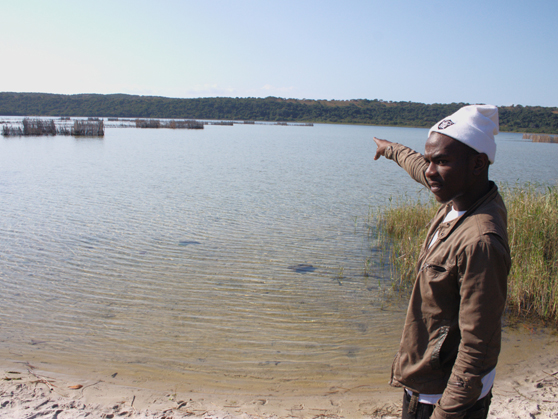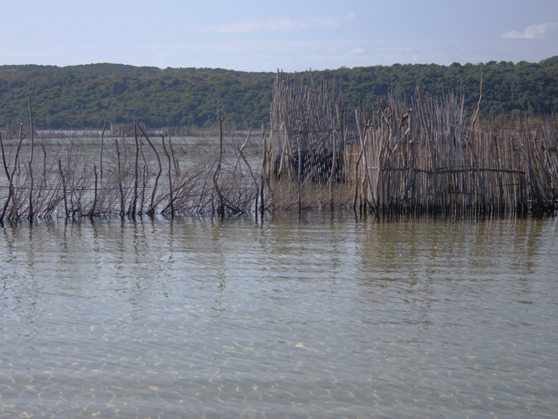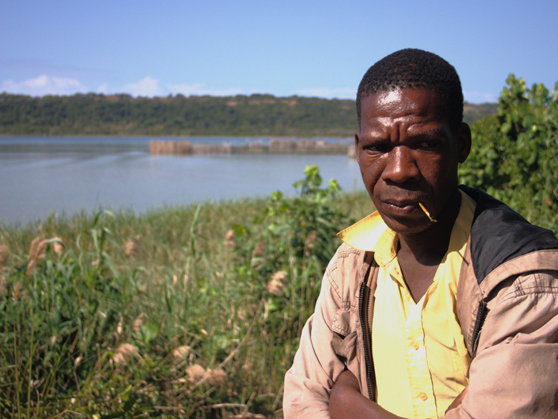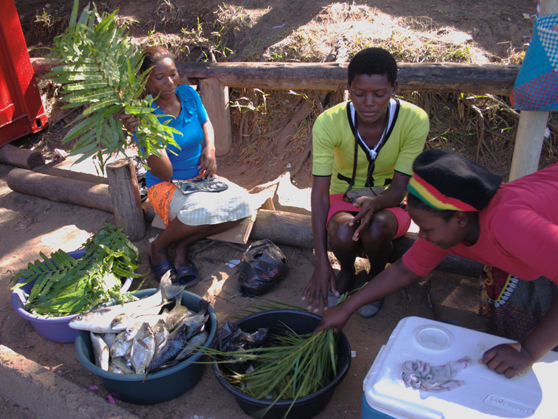So long and thanks for all the fish

Clans living near Kosi Bay have used an ancient fish trapping system to create a livelihood for themselves and their families for centuries. But as population pressure rises, increasing the twin stressors of poverty and unemployment, how long will the fragile balance between humans and nature provide a bountiful catch? Mandy de Waal travelled to uMhlabuyalingana for GroundUp. Jon Pienaar took the photographs.
“Economically backward.” That’s how Statistics South Africa describes the uMhlabuyalingana local municipality, situated in the far northern-eastern reaches of this country. It is the place where Kwazulu-Natal meets Mozambique. It is home to towns like Manguzi, that 4x4’s roar through en-route to Kosi Bay or its neighbouring coastal states.
But first-hand experience reveals a deeply rural area that’s industrially underdeveloped, but far from ‘backward’. The small town of Manguzi is alive with industry, and on a Saturday morning traders sell home-grown fresh produce along the town’s main street in front of pop-up tented hair salons. Small, independent shops outnumber bigger retail brands like Spar, Pep and Edgars while Chinese clothing retailers and Nigerian traders have made this frontier town home. Similarly pavement cuisine is on sale adjacent to the local KFC.
Fifteen kilometres away from Manguzi, on the lake shores of Kosi Bay, life is different. Here ancient wisdom is used to harvest food alongside Kosi Bay - which isn’t a bay at all but a system of four interlocking lakes that meets the Indian Ocean. Living adjacent to the Makhawulani, Mpungwini, Nhlange and Amanzimnyama lakes, families have built fish traps for survival for some 700 years.
But in recent decades fishing here has become small scale commercial. Increased population pressure, unemployment and the rising cost of living has seen middlemen moving in. Fish are still being caught and eaten by the lake clans, but are being sold to supplement subsistence.
At the pristine shore of Lake Amanzimnyama a young boy’s bare feet beat a dusty path towards us, fish at his side dripping a wet trail under the winter sun. Nsika ‘King’ Ngubane, Jon Pienaar and I watch him approach from a distance. Our interpreter is hip-hop from his All Stars covered feet to his branded beanie. The youth carrying the fish is clothed in a threadbare T-shirt and shorts.
The boy with the fish makes to walk around us, however Ngubane breaks his progress with a request for conversation. The boy answers respectfully, but with a tone that’s withdrawn, if not aloof.
King Ngubane says the people who live off the land next to the lakes fear being shamed on Facebook. “They are scared people will take their photos and put them on Facebook. They don’t want to be laughed at,” the security guard cum interpreter-for-a-day says.

King Ngubane points to the fish traps.
The emergence of the middlemen means mobile phones are now an important part of life on the lakes. Cellular telephony is used by fish trappers to communicate with town sellers to announce the catch of the day. And so social media –with all its shame and glory– has reached this remote, rural community.
Ngubane entreats the young boy with the fish to have his photograph taken. The child declines and starts leaving, but then turns to say a photograph can be taken of his fish only. The catch ranges in size. Firm, full-sized specimens hang from a sisal cord threaded through the streamlined creatures’ mouths, alongside a clutch of undersized fish.
Ngubane says the smaller fish must have been caught using a rod. He explains that the traditional fish traps are built according to an age-old, sustainable manner. He adds that these traps use the ebb and flow of the tide to trap fish. The traps are built out of tree branches and other local materials. They look like curved stick fences sticking out from the edges of the lake where the water is currently calf to thigh high.
Robert ‘Scotty’ Kyle, a researcher resident in Kosi Bay who works as Ezemvelo KZN Wildlife’s ecologist, has been investigating and counseling on fishing sustainability in the area for over thirty years. Kyle describes how the fish traps function in one of his many research papers.
“The fence of the traps is usually begun at the edge of the channel, curving towards the middle and then usually turning upstream, forming an open figure 6,” writes Kyle, adding: “At the end of the guide fence is a fish-catching basket with a valve which allows fish to enter freely but inhibits escape. From the baskets another fence continues a short distance back towards the bank forming a funnel to guide fish into the valved basket.” Fish funnel into the baskets at night, and trap owners spear them the next day.

A traditional fish trap used in Kosi Bay.
In another paper, Kyle writes that at one time people started modifying the traps using gut and other non-traditional material to catch more fish - to keep the smaller fish in. This threatens the sustainability of the fish supply. But monitoring using locals, patient negotiation with local tribal authorities and counselling local fishers has realised a return to the older, more sustainable methods.
Back at the lakes there’s a man standing on a tree stump, looking out at the traps. The man says his name is Wholesome, and quickly adds he’d prefer not to reveal his surname. He speaks Zulu, but with Ngubane’s help Wholesome explains that he was born near the lakes in 1976 and watched how other people made a life for themselves using fish traps.
These enclosures fixed in the water are made of reeds and thin branches, that are stripped of all their leaves. The local clans passed on the knowledge of how to build these enclosures from generation to generation, but Wholesome learned another way - by watching carefully and by putting what he saw into practice.
Wholesome tells us he catches fish to eat, but also sells fish to support his family. He has three children and a wife, and lives with his two parents whom he also looks after. “I am OK because I can live from what I do. I don’t have to steal,” Wholesome says.
“If the fish is small I eat it. If it is bigger, I sell it,” he says and gestures to show the sizes of fish he catches, while revealing how much each size is sold for. During a good season Wholesome explains that a fish of some 90 centimetres would sell for R150. Smaller fish of about 40 centimetres only get R50. The catch normally includes bream, mullet, grunter, rock salmon and ‘king fish’.
Like most days, today Wholesome was up early checking his four traps, and seeing whether any of them required maintenance. He doesn’t worry about anyone stealing fish from his traps. “It is a crime to go into another’s trap,” he tells us. “If you are found stealing from another person’s trap you are in trouble. You will get a small beating. That is the tradition. That is how we do it here,” Wholesome says.
Asked to describe his life, Wholesome says, “I don’t have a problem because I can live. I am happy with what I have. I can quit any time because I have the fish. I am free. I am happy as long as there is family and there is fish.”

Wholesome eats and sells the fish he catches. “I am happy as long as there is family and there is fish,” he says.
In the rainy season and summer months Wholesome says the fish are plentiful, but in the drier months, weeks can go by when he makes no money at all. “Winter is not good,” he says. “The fish are less.” But there is another problem. Wholesome says the number of people who are now fishing has increased “a lot”.
The Kosi Bay lake system, which was declared South Africa’s first World Heritage site in 1999, is part of the iSimangaliso Wetland Park and is managed in tandem with Ezemvelo KZN Wildlife. Kyle writes about why fish trapping has burgeoned. “In the early 1980s Kosi Bay was a rural backwater of apartheid South Africa with almost no employment opportunities. The migrant labour system milked the area of its youth,” the ecologist states.
When apartheid ended, Kyle writes, large numbers of men returned to Kosi Bay, but were unemployed. “The result was a marked and sustained increase in the number of traps, with more than a doubling in numbers between 1994 and 2000,” he states. Today this pressure is being increased by retrenched miners and foreign nationals pushing southwards into South Africa.
Wholesome’s phone rings. He turns away from us and looks out over the massive expanse of water and speaks into his mobile. It is one of his customers looking for fish. “The customers they come to me to buy fish. But today I have nothing.”
Back in Manguzi the search for fresh fish traders is on. We walk the length of the informal markets that populate the main street and the roads bleeding off from it. Produce, food, material and imported Chinese wares are abundant, but there’s no fresh fish in sight. We’re pointed toward the middle of the town where a container reveals a hand-drawn picture of a fish and a mobile phone number.

Selling fish at the market in Manguzi.
Alongside the container the elderly men indicate a group of six women and young girls who sit with cooler-boxes and plastic sinks covered with ferns. After some discussion the ferns part and the cooler boxes open to reveal plump bream, grunter, mullet and stump nose. Here a 45cm bream will cost R70 - a R20 mark-up from the price quoted by Wholesome.
In its profile the Umhlabuyalingana local municipality states that 47% of the region’s “economically active population receives either no income, or less than R1,600 per month.” The area has been demarcated as a Presidential node because of the extreme poverty. But during the weeks these journalists spent there we never witnessed anyone begging.
“The people of Manguzi are proud. And they know how to work. We work hard here,” King Ngubane says, adding that the people who live in the area make a plan. They help and support each other. They plough and plant. They sell and, like their parents and grandparents before them, they make traps and catch fish that they eat and sell so they can send their sons and daughters to school.
Ezemvelo KZN Wildlife’s Kyle has been involved in one of the most wide-scale fish monitoring projects to oversee catches, which include the trapping as well as recreational fishing that tourists travel to Kosi Bay for. In a paper titled Thirty years of monitoring traditional fish trap catches at Kosi Bay, KwaZulu-Natal, South Africa, and management implications Kyle writes: “Information from the fish trap monitoring, together with results from fish mark and recapture studies, suggest a very high, and possibly unsustainable, catch rate that requires management intervention to return them back to historical and sustainable levels.”
For centuries a careful balance between humans and nature has provided sustenance and enabled both to flourish. But for how long, as population pressure and people entering SA through Mozambique adds to the local stresses caused by poverty and unemployment?
Mandy de Waal and Jon Pienaar are on a self-funded journey across South Africa to meet people where they live and work.
The article title is from the fourth book in the Hitchhiker’s Guide to the Galaxy series by Douglas Adams.
Support independent journalism
Donate using Payfast

Don't miss out on the latest news
We respect your privacy, and promise we won't spam you.

This article is licensed under a Creative Commons Attribution-NoDerivatives 4.0 International License.
